A century in the past, the Milky Manner galaxy was the whole thing of the recognized universe. We had no concept what made the celebs shine, and just one star — our personal solar — was recognized to harbor any planets. Of these planets, people had explored just one: Earth.
“The stellar universe, as we all know it … is a flattened, watch-shaped group of stars and nebulae,” astronomer Harlow Shapley wrote in Science Information Bulletin, the earliest model of Science Information, in August 1921 (SN: 8/8/1921, p. 3). That glowing pocket watch was the Milky Manner, and on the time Shapley wrote this, astronomers had been simply starting to conceive that something in any respect would possibly lie past it.
As we speak, spacecraft have flown by each one of many photo voltaic system’s planets, taking close-ups of their wildly alien faces. The photo voltaic system, it seems, comprises a cornucopia of small rocky and icy our bodies which have challenged the very definition of a planet. 1000’s of planets have been noticed orbiting different stars, a few of which can have the best situations for all times to thrive. And the Milky Manner, we now know, is only one of billions of galaxies.
The final 100 years have introduced a collection of revolutions in astronomy, each kicking Earth a bit farther from the middle of issues. Alongside the best way, folks haven’t precisely been receptive to those blows to our dwelling planet’s centrality. In 1920, the query of whether or not there may very well be different “island universes” — galaxies — was the topic of the Nice Debate between two astronomers. Within the Nineteen Seventies, when Mars was proven to have a pink sky, not blue, reporters booed. Their response “displays our want for Mars to be identical to the Earth,” stated astronomer Carl Sagan afterward. And within the Nineties, astronomers nearly missed extrasolar planets hiding of their knowledge as a result of they’d tailor-made their search methods to search out planets extra like these in our personal photo voltaic system.
However turning our focus from Earth has opened our minds to new potentialities, new universes, new locations the place life would possibly exist. The subsequent century of astronomy might carry higher views of our cosmic origins and new methods for locating worlds that different creatures name dwelling.
The misperceptions of a long time previous counsel scientists must be cautious when predicting simply what we’ll discover sooner or later.
“You be taught numerous humility on this enterprise,” says planetary scientist Candice Hansen of the Planetary Science Institute, based mostly in Tucson. “You all the time be taught much more if you’re incorrect than if you’re proper.”
Signal Up For the Newest from Science Information
Headlines and summaries of the newest Science Information articles, delivered to your inbox
Greater than the Milky Manner
On the flip of the twentieth century, standard knowledge held that the Milky Manner stood alone. It contained stars, typically organized in clusters, and fuzzy patches of sunshine generally known as nebulae. That was about it.
Some nebulae had spiral constructions, “showing within the telescope like huge Fourth-of-July pinwheels,” as Science Information Letter, the predecessor of Science Information, described them in 1924. Within the 18th century, German thinker Immanuel Kant had described nebulae as “greater universes,” or, “so to talk, Milky Methods.” However by the early 1900s, most astronomers thought that drawing that parallel was ridiculous.
“No competent thinker,” wrote historian of astronomy Agnes Clerke in 1890, can “keep any single nebula to be a star system of coordinate rank with the Milky Manner.”
By the Twenties, although, that view was already being challenged. As early as 1914, astronomer Heber Curtis of Lick Observatory in California argued that spiral nebulae should not a part of the Milky Manner, however quite “inconceivably distant galaxies of stars or separate stellar universes so distant that a complete galaxy turns into however an unresolved haze of sunshine.”
Across the identical time, Shapley, of Mount Wilson Observatory in California, started to show that the Milky Manner itself was inconceivably huge.
Shapley constructed on work by Henrietta Leavitt, certainly one of a bunch of girls “computer systems” at Harvard College who pored over photographic plates capturing the night time sky. In learning pictures of the Magellanic Clouds, which we now know are two small galaxies that orbit the Milky Manner, Leavitt observed that sure stars various in brightness over time, a few of them in a peculiar manner. “It’s worthy of discover,” she wrote in 1908, that “the brighter variables have the longer durations.” In different phrases, brighter stars twinkled extra slowly.
 Within the early 1900s, astronomer Henrietta Leavitt found a function of sure stars, referred to as Cepheid variables, that helped different astronomers measure cosmic distances. These stars in the end helped show that the Milky Manner is only one of many galaxies.Picture by Margaret Harwood, courtesy of AIP Emilio Segrè Visible Archives, Physics As we speak Assortment, Shapley Assortment
Within the early 1900s, astronomer Henrietta Leavitt found a function of sure stars, referred to as Cepheid variables, that helped different astronomers measure cosmic distances. These stars in the end helped show that the Milky Manner is only one of many galaxies.Picture by Margaret Harwood, courtesy of AIP Emilio Segrè Visible Archives, Physics As we speak Assortment, Shapley Assortment
That meant that these variable stars, referred to as Cepheids, may very well be used to estimate cosmic distances. It’s onerous to inform how distant a cosmic object really is — bright-looking stars may very well be intrinsically dim however shut, whereas faint-looking stars may very well be intrinsically vivid however distant. However all of the Cepheids inside the identical cloud must be roughly the identical distance from Earth. That meant “their durations are apparently related to their precise emission of sunshine,” Leavitt wrote in 1912. To determine any Cepheid’s true brightness, all an astronomer needed to do was measure its twinkling pace. It was a brief step from there to determining its distance.
Shapley put this reality to make use of only a few years later, measuring distances to Cepheids inside globular clusters of stars to determine the solar’s place within the Milky Manner. To his shock, the solar was not within the middle of the galaxy however off to at least one facet. The Milky Manner’s starry disk was additionally about 10 instances wider than earlier astronomers had assumed: about 300,000 light-years throughout, in line with his calculations. (He overshot a bit; trendy astronomers suppose it’s someplace between 120,000 and 200,000 light-years.)
He and Curtis took their opposing views to the general public at a gathering of the Nationwide Academy of Sciences in Washington, D.C., in April 1920, in an occasion that grew to become generally known as the Nice Debate. Every had 40 minutes to current their views on whether or not there is just one or a number of universes — what we now consider as galaxies.
Shapley, who was in his 30s and thought of a rising star within the area, went first. A former journalist who reportedly was uncomfortable chatting with crowds, he learn his argument from a typewritten script. He barely touched on the query of different universes, focusing as a substitute on his new measurements of the Milky Manner’s measurement. The implication was that the Milky Manner was too massive for different galaxies to make sense.
Curtis was an older, well-respected authority on spiral nebulae, in addition to a gifted speaker. He argued for the then-standard view that the Milky Manner was a lot smaller than Shapley supposed. However even a big Milky Manner shouldn’t negate the potential of different, equally massive galaxies, he argued. The spectra of sunshine coming from spiral nebulae was related sufficient to that of the Milky Manner that they may very well be related objects, he maintained.
Each astronomers had been partly proper, and partly incorrect.
Galaxies come into sight
The Nice Debate was resolved by a younger astronomer named Edwin Hubble working at Mount Wilson. Hubble additionally used Leavitt’s Cepheid variable method to measure cosmic distances, this time by discovering the variable stars within the spiral nebulae themselves.
Hubble began observing the Andromeda nebula, one of many brightest nebulae on the sky, within the fall of 1923. He used Mount Wilson’s 60-inch telescope and its 100-inch telescope, then the world’s largest. Over the subsequent 12 months or so, he studied 35 Cepheids in Andromeda and a special nebula referred to as Triangulum. Their durations had been lengthy sufficient that the nebulae needed to be on the order of one million light-years away for the celebs to look so faint. (We now comprehend it’s extra like 2.5 million light-years to Andromeda and a couple of.7 million to Triangulum.)
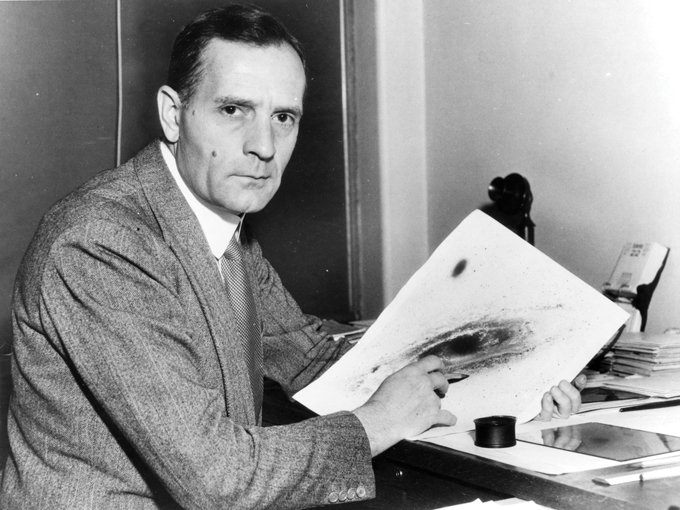 Astronomer Edwin Hubble, proven right here holding a drawing of a galaxy, proved that there are different galaxies outdoors of the Milky Manner.Hale Observatories, courtesy of AIP Emilio Segrè Visible Archives
Astronomer Edwin Hubble, proven right here holding a drawing of a galaxy, proved that there are different galaxies outdoors of the Milky Manner.Hale Observatories, courtesy of AIP Emilio Segrè Visible Archives
“Measuring the gap to Andromeda was a giant deal as a result of it was the primary proof that there are galaxies past our personal,” says astronomer Emily Levesque of the College of Washington in Seattle. “It modified what we regarded as the form of our universe.”
A couple of hints that the Milky Manner was not alone had cropped up earlier than that, however Hubble’s discovering clinched it. Even when the Milky Manner was as large as Shapley claimed, Andromeda lay outdoors its borders. When Shapley obtained Hubble’s paper, he reportedly stated, “Right here is the letter that destroyed my universe.”
Science Information Letter reported Hubble’s discovering below the headline “Sky Pinwheels Are Stellar Universes 6,000,000,000,000,000,000 Miles Away” in December 1924 (SN: 12/6/24, p. 2).
“It appears possible that lots of the smaller spiral nebulae are nonetheless extra distant and seem smaller on this account,” the story quotes Hubble as saying. “The portion of the universe inside the vary of our investigation consists of huge numbers of stellar galaxies akin to our personal, scattered about by way of practically empty area and separated from each other by distances of inconceivable magnitude.” Right here ultimately was the fashionable view of the universe.
By the top of the last decade, Hubble had not solely proven that the spiral nebulae had been “island universes,” he additionally had begun to categorise completely different galaxy sorts and take into consideration how they advanced over time. What’s extra, he confirmed that galaxies had been flying away from one another at speeds proportional to their distance. In different phrases, the universe was increasing.
By the top of the century, astronomers knew that the universe was dotted with billions of galaxies of all sizes and shapes. In April 1990, NASA launched the primary optical area telescope into Earth’s orbit, giving the world a brand new perspective on area.
“As an alternative of those blurry blobs from even the very best mountaintop observatories on our planet,” says planetary scientist Jim Bell of Arizona State College in Tempe, “swiftly the whole realm of photo voltaic system, galaxy, extragalactic … was opened up by getting above the ambiance.”
NASA named the telescope after the scientist who opened astronomers’ minds to the existence of such a universe: the Hubble Area Telescope.
The pictures it has captured over 30 years of operations — star clusters, galaxies and nebulae — are so iconic they’re printed on all the things from socks and low mugs to excessive style runway designs. The telescope itself was not too long ago immortalized in Lego kind.
“It’s the one which actually everybody has heard of,” says Levesque. Most individuals in the present day suppose Hubble was “the man who constructed the telescope.”
One picture from early on within the area telescope’s tenure stands out. In December 1995, the telescope’s director, Robert Williams, determined to coach the observatory on a tiny, darkish patch of sky close to the deal with of the Huge Dipper for 10 consecutive days. The ensuing portrait of this featureless little bit of sky revealed 1000’s of beforehand unknown galaxies sending their mild from farther away than astronomers had ever seen earlier than (SN: 1/20/96, p. 36). The universe as Edwin Hubble had imagined it, chock-full of island universes, was captured in a single onerous look.
As for Henrietta Leavitt, she missed out on the popularity she deserved for serving to knock the Milky Manner from its central perch. A Swedish mathematician wrote to her in 1925 saying that her work “has impressed me so deeply that I really feel critically inclined to appoint you to the Nobel Prize in physics for 1926.” He obtained a reply from Shapley, by then director of the Harvard School Observatory: Leavitt had died 4 years earlier.
Steps to Mars
The primary liquid-fueled rockets, precursors to those that later carried robots and folks into area, launched within the Twenties. A century later, robots have flown previous, orbited or landed on each planetary physique that was recognized in 1920, and some that weren’t. Folks have walked on the moon and have lived in area for greater than a 12 months at a time. And severe talks about sending folks to Mars are within the works.
NASA used to discover different worlds in a transparent order, first observing with telescopes after which finishing up more and more complicated missions: flybys, orbiters, landers, rovers, then folks and pattern returns. “We’ve taken that whole development on the moon, in [the last] century,” Bell says. “Someday on this new century, we’ll add Mars to that listing. All the remainder of the photo voltaic system, we’ve acquired massive chunks of that matrix checked off.”
After the Soviet Union launched the primary synthetic satellite tv for pc, Sputnik 1, in 1957, area launches got here quick and livid. Many had been demonstrations of political and army would possibly. However numerous them had scientific advantage, too. The Soviet Luna 3 spacecraft photographed the farside of the moon in 1959 — shortly after NASA’s founding. Spacecraft flew previous Venus and Mars within the Sixties, sending again the primary closeup knowledge on their alien atmospheres and surfaces.
That very same decade, people landed on the moon and introduced again rocks, opening a large and detailed window into the historical past of the photo voltaic system. The lunar samples from the Apollo missions gave scientists a manner to determine how outdated planetary surfaces are across the photo voltaic system, taught us that the whole inside photo voltaic system was bombarded with impacts in its youth and gave us an origin story for the moon (SN: 7/6/19 & 7/20/19, p. 18).
“Till we began the area program, we actually had no concept what the geology was on different locations,” says Hansen of the Planetary Science Institute. “Early within the century, they had been nonetheless debating whether or not the craters on the moon had been affect craters or volcanic calderas. Even proper there in our personal yard, we didn’t know what was occurring.”
And extraterrestrial geology was stunning. With out which means to, planetary scientists had based mostly numerous their expectations for different worlds on the Earth. The duvet of Science Information from June 1976, the month earlier than NASA’s Viking 1 lander grew to become the primary long-lived spacecraft to land softly on Mars, confirmed Mars with a Cheez Whiz–coloured desert below a transparent blue sky. Within the sleep-deprived rush to launch the primary shade photos despatched again by Viking 1, scientists processed the picture to provide a blue sky there, too.
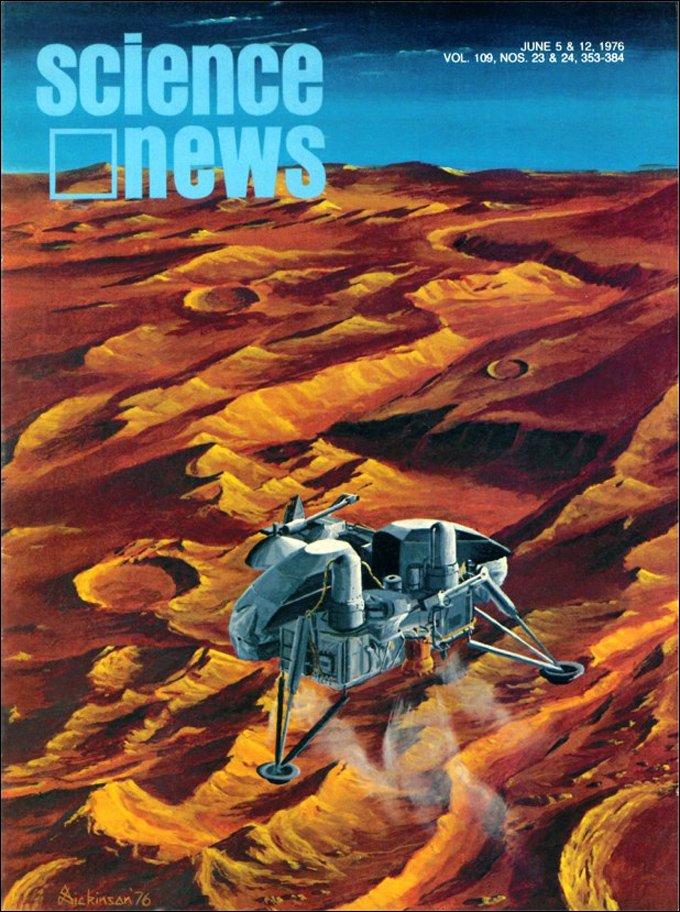 Earlier than NASA’s Viking 1 spacecraft landed on Mars in July 1976, Science Information and others envisioned the Pink Planet with a blue sky. Mars’ sky is definitely a dusty yellowish-pink.
Earlier than NASA’s Viking 1 spacecraft landed on Mars in July 1976, Science Information and others envisioned the Pink Planet with a blue sky. Mars’ sky is definitely a dusty yellowish-pink.
However the day after the touchdown, James Pollack of the imaging crew informed reporters that the Martian sky was truly pink, in all probability because of scattered mild from mud particles suspended within the air.
“Once we discovered the sky of Mars to be a form of pinkish-yellow quite than the blue which had erroneously first been reported, the announcement was greeted by a refrain of good-natured boos from the assembled reporters,” Sagan later wrote within the introduction to his standard guide Cosmos. “They wished Mars to be, even on this respect, just like the Earth.”
Nonetheless, the Viking 1 and a couple of landings introduced Mars all the way down to Earth, so to talk. “Mars had turn out to be a spot,” Viking challenge scientist Gerald Soffen stated in an interview for a NASA historic challenge printed in 1984. “It went from a phrase, an summary thought, to an actual place.”
In some methods, the Viking landers’ views of Mars had been disappointing. The mission’s central objective was explicitly to seek for microbial life. It was “a protracted shot,” journalist Janet L. Hopson wrote in Science Information in June 1976 (SN: 6/5/76, p. 374). However “even when no indicators of life seem, [biologists] stand to achieve their first actual perspective on terrestrial biochemistry, life origins and evolution.”
The outcomes of the Viking mission’s life-detection experiments had been inconclusive, a discovering nearly worse than a real detrimental.
NASA subsequently pulled again from looking for life instantly. The subsequent 45 years of Mars missions looked for indicators of previous water, doubtlessly liveable environments and natural molecules, as a substitute of residing organisms. All of these options turned up in knowledge from the Spirit, Alternative and Curiosity rovers within the 2000s and 2010s.
Now, NASA’s Perseverance rover, which landed in February 2021, is attempting to find indicators of historic microbial life. The rover will cache rock samples {that a} future mission will carry again to Earth. And the joint Russian and European area businesses’ ExoMars rover — named Rosalind Franklin, after the chemist whose work was central to discovering DNA’s construction — goals to hunt molecular signatures of life on Mars and slightly below the floor after it launches in 2022.
Sagan predicted in 1973 that if he had been born 50 years sooner or later, the seek for life on Mars would have already been accomplished. As we speak, 48 years later, we’re nonetheless wanting.
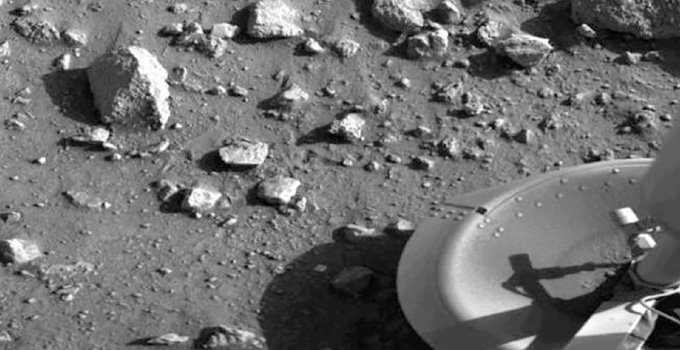 The primary picture taken on the floor of Mars, in July 1976, reveals the footpad of NASA’s Viking 1 lander and the rocks of a basin referred to as Chryse Planitia.NASA
The primary picture taken on the floor of Mars, in July 1976, reveals the footpad of NASA’s Viking 1 lander and the rocks of a basin referred to as Chryse Planitia.NASA
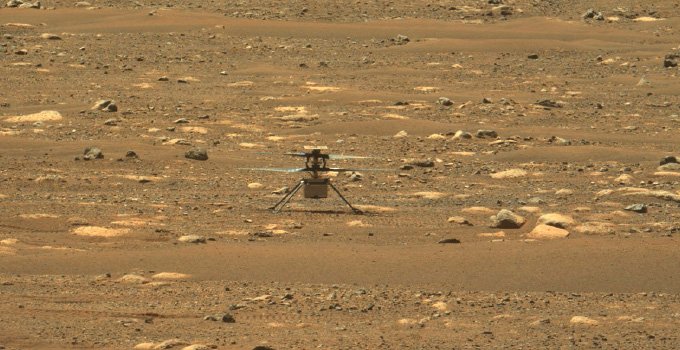 Virtually 45 years later, the small helicopter Ingenuity landed with the Perseverance rover and have become the primary robotic to fly within the skinny Martian ambiance. Its blades span 1.2 meters.JPL-Caltech/NASA, Arizona State Univ.
Virtually 45 years later, the small helicopter Ingenuity landed with the Perseverance rover and have become the primary robotic to fly within the skinny Martian ambiance. Its blades span 1.2 meters.JPL-Caltech/NASA, Arizona State Univ.
Unique moons
The 12 months after the Vikings landed on Mars, one other pair of spacecraft launched to test nearly the whole remainder of the photo voltaic system off scientists’ must-see listing. Astronomers realized that in 1977, the planets would line up in such a manner {that a} spacecraft launched that 12 months might attain Jupiter, Saturn, Uranus and Neptune one after the other, stealing a bit angular momentum from every world because it went alongside. The mission was dubbed Voyager (SN: 8/27/77, p. 132).
“There’s by no means been something prefer it, and there by no means will likely be once more,” says Bell, of Arizona State. “It was akin to the voyages of Magellan or Darwin or Lewis and Clark. Simply a completely profound mission of discovery that utterly modified the panorama of planetary science on this century.”
Voyager’s views of the outer photo voltaic system compelled scientists to suppose outdoors of the “Earth field,” says Hansen, who labored on the mission. “The Voyager imaging crew, bless their hearts, they might make predictions after which they’d be incorrect,” she says. “And we might be taught one thing.”
Hansen remembers chatting with a member of the imaging crew when the spacecraft was approaching Jupiter and its dozens of moons. “He stated, ‘Sweet, we’ll see craters on [moons] Io and Europa, as a result of we all know from the density that these are rocky worlds. However not on Ganymede and Callisto, as a result of these are ice,’ ” she remembers. As an alternative, the photographs confirmed Ganymede and Callisto had been coated in craters. “That was an aha second — ice goes to behave like rock at these temperatures.” In the meantime, ocean-swathed Europa and molten Io had nearly no craters.
The moons of Jupiter introduced “a complete, beforehand unimagined household of unique worlds, every radically completely different not solely from its companions, but additionally from all the things else within the planet-watcher’s expertise,” journalist Jonathan Eberhart wrote in Science Information in April 1980 (SN: 4/19/80, p. 251).
Earlier than 1979, Earth was the one geologically energetic, rocky world scientists knew about. However Voyager modified that view, too. A member of Voyager’s optical navigation crew, Linda Morabito, noticed an odd, mushroom-shaped function extending off the sting of Io whereas she was attempting to plot the spacecraft’s place on March 9, 1979. She consulted with the science crew, and so they quickly realized they had been a big volcanic plume. Io was erupting in actual time.
Three planetary scientists had predicted Io’s hearth earlier than the plumes had been found. The three recommended the moon was heated by a gravitational tug-of-war between Jupiter and one or two of its different moons, Europa and Ganymede.
However a lot of the planetary science group was surprised. “We take gravity without any consideration right here. It retains our ft on the bottom,” Hansen says. “However gravity molds and shapes so many issues in so many surprising methods.”
Voyager and subsequent missions to the outer planets, like Galileo at Jupiter within the Nineties and Cassini at Saturn within the 2000s, reworked our view of the photo voltaic system in one other profound manner. They revealed a number of stunning elements of the photo voltaic system the place life would possibly exist in the present day.
Voyager hinted that Europa may need a liquid water ocean beneath an icy shell. Galileo strengthened that concept, and recommended the ocean may be salty and have contact with the moon’s rocky core, which might present chemical vitamins for microbial life. NASA is now creating a mission to fly previous Europa. “I cannot be shocked if life is by some means found on Europa in my lifetime, or on this century,” Bell says.
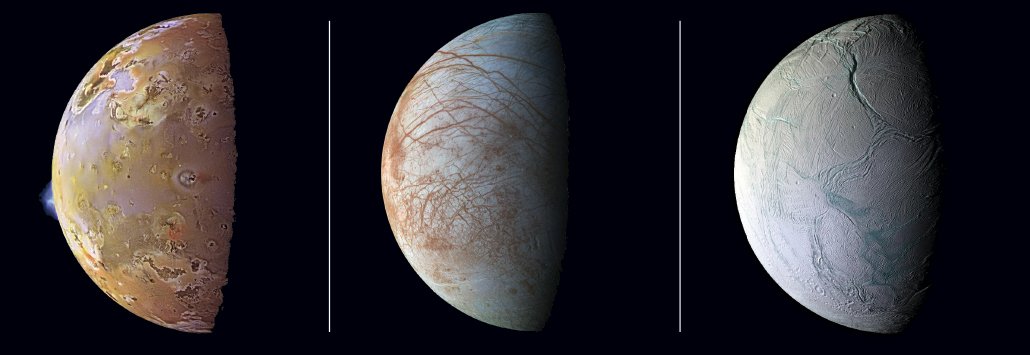 Spacecraft have revealed that some moons let their insides out. Jupiter’s moon Io (left) spurts plumes of magma as excessive as 390 kilometers into the air. Jupiter’s moon Europa (middle) and Saturn’s moon Enceladus (proper) each host subsurface seas and should vent water into area.From left: JPL-caltech/NASA, Univ. of Arizona; JPL-Caltech/NASA, SETI Institute; JPL-caltech/NASA, Area Science Institute
Spacecraft have revealed that some moons let their insides out. Jupiter’s moon Io (left) spurts plumes of magma as excessive as 390 kilometers into the air. Jupiter’s moon Europa (middle) and Saturn’s moon Enceladus (proper) each host subsurface seas and should vent water into area.From left: JPL-caltech/NASA, Univ. of Arizona; JPL-Caltech/NASA, SETI Institute; JPL-caltech/NASA, Area Science Institute
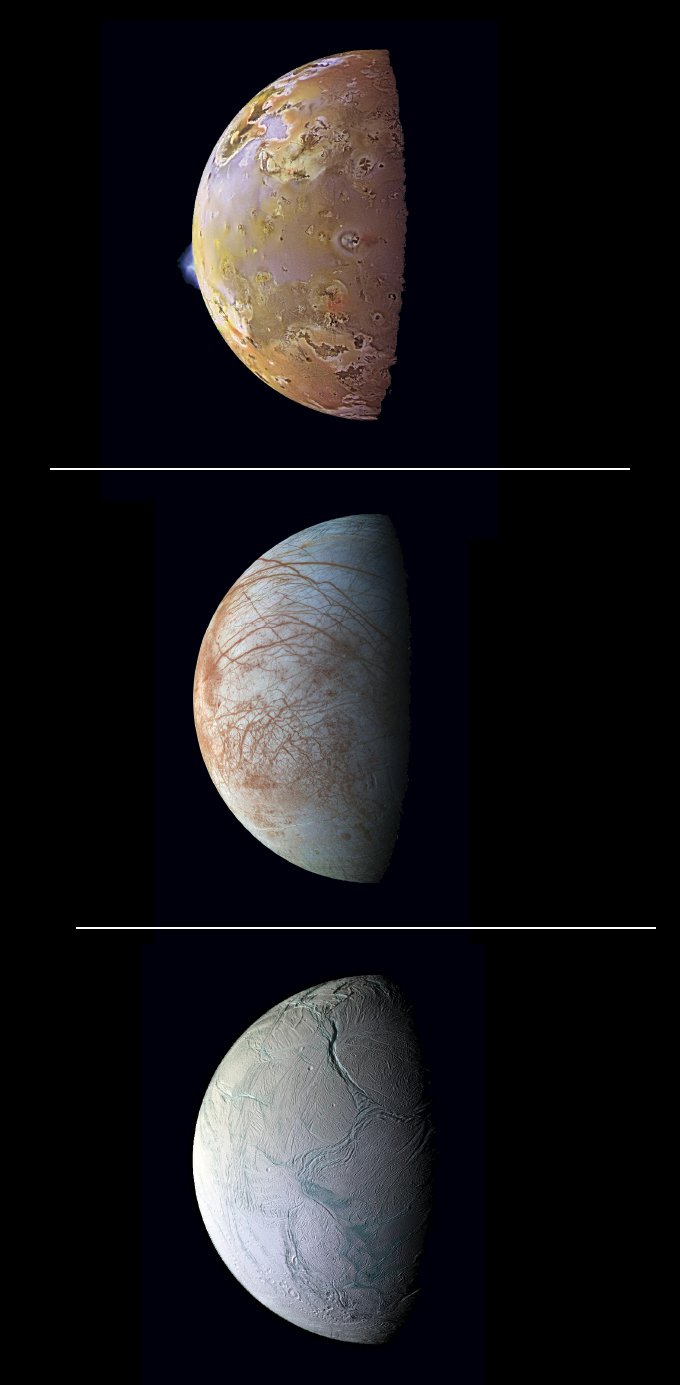 Spacecraft have revealed that some moons let their insides out. Jupiter’s moon Io (prime) spurts plumes of magma as excessive as 390 kilometers into the air. Jupiter’s moon Europa (middle) and Saturn’s moon Enceladus (backside) each host subsurface seas and should vent water into area.From prime: JPL-caltech/NASA, Univ. of Arizona; JPL-Caltech/NASA, SETI Institute; JPL-caltech/NASA, Area Science Institute
Spacecraft have revealed that some moons let their insides out. Jupiter’s moon Io (prime) spurts plumes of magma as excessive as 390 kilometers into the air. Jupiter’s moon Europa (middle) and Saturn’s moon Enceladus (backside) each host subsurface seas and should vent water into area.From prime: JPL-caltech/NASA, Univ. of Arizona; JPL-Caltech/NASA, SETI Institute; JPL-caltech/NASA, Area Science Institute
Shortly after the Cassini spacecraft arrived at Saturn in 2004, scientists realized that the tiny moon Enceladus vents dramatic plumes of water vapor, mud and ice crystals into area from a hidden subsurface sea. That moon additionally appears to be like like place for all times.
If the final century of exploring the photo voltaic system was about coming to grips with alien geology, Hansen says, this coming century goes to be about oceanography — getting a grip on the unusual seas in our personal photo voltaic system.
“I believe that’s going to form numerous the analysis going ahead,” Hansen says. Now that it’s clear these moons have oceans, researchers will ask if they’re liveable, and ultimately, if they’re inhabited.
Exoplanets detected
The primary planet noticed outdoors our photo voltaic system — an exoplanet — was so completely different from something in our photo voltaic system that astronomers weren’t attempting to find something prefer it.
“Understanding that there are literally planets round different stars now appears so trivial to say,” says exoplanet observer Debra Fischer of Yale College. “However we had arguments in 1995 about whether or not different stars have planets.”
So when astronomer Michel Mayor of the Geneva Observatory turned his spectrograph on the sky in April 1994, he stored quiet about his hopes of discovering true exoplanets. He was extra prone to discover brown dwarfs, failed stars that by no means grew huge sufficient to burn hydrogen.
His instrument used a intelligent new option to hunt for different worlds, referred to as the radial velocity method. Earlier exoplanet hunters had appeared instantly for a star’s movement in response to the gravity of an orbiting planet, watching to see if the star would transfer backwards and forwards within the sky. That method had led to a number of planetary claims, even courting again to 1855, however none of them had held up. These motions are tiny; Jupiter’s affect strikes the solar by simply 12 meters per second.
As an alternative, Mayor and others studied a shift within the wavelength of starlight as a star moved backward and forward. As a star approaches us, the sunshine shifts to shorter, or bluer, wavelengths; because it strikes away, the sunshine grows redder. Calculating the speed of a star’s back-and-forth movement, astronomers might work out the minimal mass and size of the 12 months of no matter was tugging that star.
The shifts Mayor was on the lookout for had been nonetheless minuscule. The search was thought of futile, and fringe — like on the lookout for little inexperienced males. So astronomers who explicitly claimed to be looking for planets had a tough time scheduling observations at telescopes. Brown dwarfs, alternatively, had been thought of authentic science, and can be simpler to detect.
So the world was astounded when, in October 1995, Mayor and his scholar Didier Queloz reported sturdy proof not of a brown dwarf, however of a real planet orbiting the sunlike star 51 Pegasi, about 50 light-years from our photo voltaic system.
The brand new planet was bizarre. It appeared to be about half the mass of Jupiter, too puny to be a brown dwarf. But it surely orbited the star as soon as each 4.23 Earth days, placing it extremely near its star. There’s nothing like that in our photo voltaic system, and astronomers had no concept the way it might exist.
“The information flashed by way of the astronomical group like a lightning bolt,” wrote journalist Ron Cowen in Science Information, within the first of three tales on the brand new planet he would write inside a month (SN: 10/21/95, p. 260).
51 Peg b, because it got here to be recognized, launched a brand new period. “It means planets exist round different sunlike stars, we are able to discover them, and so they may be the thrilling ones,” says Yale anthropologist Lisa Messeri, who has studied how astronomers create worlds out of pixels and spectra. “Firsts are thrilling as a result of they promise there will likely be seconds and thirds and fourths.”
The search was on. A bunch from San Francisco rapidly discovered two extra planets hiding in knowledge the researchers hadn’t completed analyzing but. These subsequent two planets, 70 Vir b and 47 UMa b, had been additionally extra huge and nearer to their stars than anticipated.
The existence of those three worlds, which had been named sizzling Jupiters as a result of their close-in orbits ought to make them sizzle, upended the paradigm for what a planet may very well be like. Clearly, our photo voltaic system was not the template for the universe.
But for a number of years after 51 Peg b was introduced, astronomers debated whether or not the planet was actually there. Possibly the star’s obvious back-and-forth was simply its outer ambiance respiratory out and in. These debates waned as extra planets had been found, but it surely took a brand new method to essentially persuade everybody.
Astronomers had predicted a minimum of again to the 1850s that some planets would go in entrance of their stars from the attitude of Earth. Because it crossed, or transited, the face of its star, a planet might reveal its presence by blocking a bit little bit of the star’s mild.
But when different photo voltaic methods are like ours, transits can be extremely troublesome to detect. Our planets are too small and too removed from the solar to solid a big shadow. Sizzling Jupiters, alternatively, ought to block far more of a star’s mild than any planets in our photo voltaic system. With the invention of 51 Peg b, transits appeared not solely potential to detect, however nearly straightforward.
The primary transiting extrasolar planet revealed itself in 1999, when then-Harvard graduate scholar David Charbonneau drove to Colorado to do his thesis work with astronomer Tim Brown. Brown had constructed a tiny telescope on a pal’s farm north of Boulder, establishing the computer systems in a repurposed turkey coop, to seek for transiting planets. By the point Charbonneau arrived, nonetheless, the farm had been bought and the telescope relocated to a lab web site.
To apply the method, Charbonneau aimed Brown’s telescope at a star, referred to as HD 209458, that already had a suspected planet. The star’s mild dimmed by about 1 p.c, after which it shone vivid once more. That was a transparent signal of a planet about 32 p.c wider than Jupiter.
That discovery ended all doubts concerning the existence of exoplanets, says Fischer, who had labored with the exoplanet-hunting group in San Francisco. “It occurred like that,” Fischer says, with a finger snap. The mixed measurement and mass of the planet unambiguously dominated out brown dwarfs or different unique explanations. “It walks like a Jupiter, talks like a Jupiter, it’s a Jupiter.”
There was one other benefit to the transit methodology: It could present the composition of a planet’s ambiance. Planets detected by the wobble method had been “little greater than phantoms,” Cowen wrote in Science Information in 2007. They had been too small to be seen, and too near the star to be photographed instantly.
“Everybody had assumed that should you wished to [detect] the ambiance of an extrasolar planet, you’d should picture it,” Charbonneau informed Science Information. However starlight filtering by way of a transiting planet’s sky might reveal what gases encompass the alien world with out the necessity for a snapshot.
Hunt for liveable planets
Transits quickly overtook wobbles as probably the most fruitful planet-finding technique. That was principally because of the launch of NASA’s Kepler area telescope in March 2009.
Kepler’s mission was explicitly about discovering different Earths. For practically 4 years, the telescope stared at 170,000 stars in a single patch of sky to catch as many transiting planets because it might. Particularly, its operators had been hoping for Earth-sized planets in Earthlike orbits round sunlike stars — locations the place life might conceivably exist.
The years that adopted had been a growth time for planet finders. By the top of its practically 10-year run, Kepler had confirmed nearly 2,700 planets and 1000’s extra potential planets. Findings went past the recent Jupiters to worlds the dimensions of Earth and planets within the “liveable zone,” the place temperatures may very well be proper for liquid water.
Discoveries got here so rapidly {that a} single new world stopped being a information story. Kepler’s knowledge shifted from revealing new worlds one after the other to taking an exoplanet census. It confirmed that sizzling Jupiters should not truly the commonest kind of planet; they had been simply the best ones to identify. The most typical kind makes no look in our photo voltaic system: worlds between the dimensions of Earth and Neptune, which can be rocky super-Earths or gaseous mini-Neptunes.
And Kepler revealed that there are extra planets within the galaxy than stars. Each one of many billions and billions of stars within the Milky Manner ought to have a minimum of one world in its orbit.
However the telescope by no means actually achieved the objective of discovering one other Earth. Kepler required three transits to substantiate a world’s existence. Which means the telescope needed to stare for a minimum of three years to discover a planet orbiting at Earth’s precise distance.
By 2013, after 4 years of observing, half of Kepler’s stabilizing response wheels had failed. The telescope couldn’t keep its unblinking view of the identical a part of the sky. Mission scientists cleverly reprogrammed the telescope to take a look at different stars for shorter spans of time. However a lot of the planets discovered there orbited nearer to their stars than Earth does, which means they couldn’t be Earth twins.
Lastly, Kepler ran out of gas in 2018, with no true Earth analog in sight.
Messeri remembers an exoplanet convention at MIT in 2011 the place numerous the dialog was about discovering a twin of Earth.
“It was a peak of pleasure — possibly we’re going to search out this planet within the subsequent three years, or 5 years. It felt shut,” she says. “What’s fascinating is, within the 10 years since then, it nonetheless feels that shut.”
However astronomers had already realized they may not want a real Earth analog to discover a planet the place life might exist. Rocky worlds orbiting smaller, dimmer stars than the solar are simpler to search out, and may be simply as pleasant to life.
Charbonneau once more was forward of the curve, having began a program referred to as MEarth in 2008 to hunt for liveable planets round puny M dwarf stars utilizing eight small telescopes in Arizona (plus one other eight in Chile that had been added in 2014). Inside six months, Charbonneau and colleagues had discovered a super-Earth dubbed GJ 1214b that’s in all probability a water world — possibly a bit too moist for all times.
The European Southern Observatory began the TRAPPIST, for TRAnsiting Planets and PlanetesImals Small Telescope, survey from La Silla, Chile, in 2010. One other telescope, at Oukaïmeden Observatory in Morocco, got here on-line to seek for planets orbiting Northern Hemisphere stars in 2016. Amongst that survey’s discoveries is the TRAPPIST-1 system of seven Earth-sized planets orbiting a single M dwarf star, three of which may be within the liveable zone (SN: 3/18/17, p. 6).
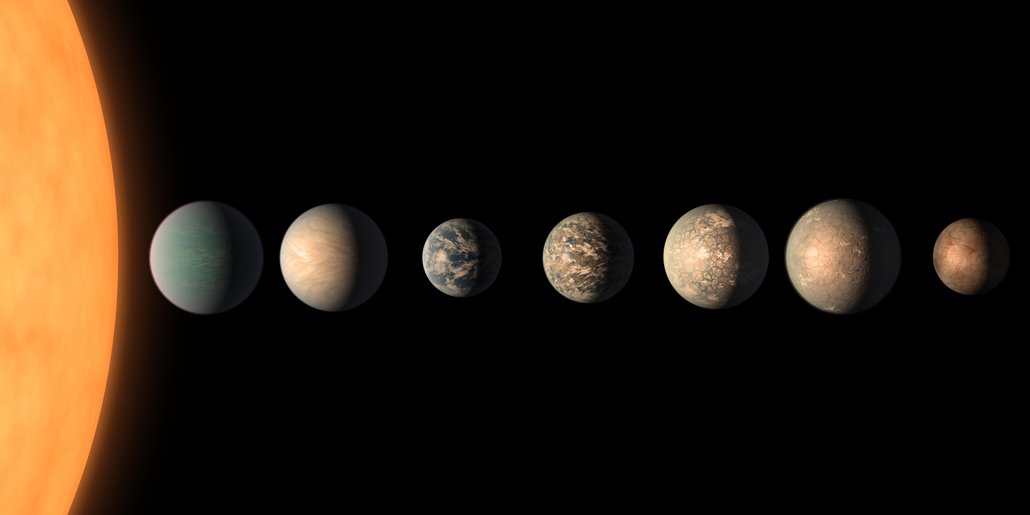 The star TRAPPIST-1 hosts seven planets (proven in an artist’s illustration) that every one in all probability have a rocky composition. At the very least three of the planets might have temperatures which can be good for all times.JPL-Caltech/NASA
The star TRAPPIST-1 hosts seven planets (proven in an artist’s illustration) that every one in all probability have a rocky composition. At the very least three of the planets might have temperatures which can be good for all times.JPL-Caltech/NASA
NASA’s successor to Kepler, TESS, or Transiting Exoplanet Survey Satellite tv for pc, has been scanning the whole sky since April 2018 for small planets orbiting vivid close by stars, together with M dwarfs. It noticed greater than 2,200 potential planets in its first full-sky scan, scientists introduced in March 2021.
As of late, astronomers are becoming a member of up with scientists throughout disciplines, from planetary scientists who research hypothetical exoplanet geology to microbiologists and chemists who take into consideration what sorts of aliens might dwell on these planets and find out how to detect these life-forms. That’s a giant shift from even 10 years in the past, Messeri says. Within the early 2010s, nobody was speaking about life.
“You weren’t allowed to say that,” she says. “Astronomers would whisper it to me throughout fieldwork, however this was not a seek for aliens.”
Exoplanet astronomy is on firmer floor now. Its main figures have gained MacArthur “genius” grants. Pioneer planet finders Mayor and Queloz gained the 2019 Nobel Prize in physics. The work is not hidden away in conferences which can be truly about stars. “It doesn’t should legitimize itself anymore,” Messeri says. “It’s an actual science.”
The promise that transiting planets can reveal the contents of their alien atmospheres might quickly be fulfilled. NASA’s James Webb Area Telescope might launch this 12 months, after a few years of delays. One in all its first duties will likely be to probe the atmospheres of transiting planets, together with these of TRAPPIST-1.
If something is alive on these completely alien, unearthly worlds, possibly the subsequent century will carry it to mild.



